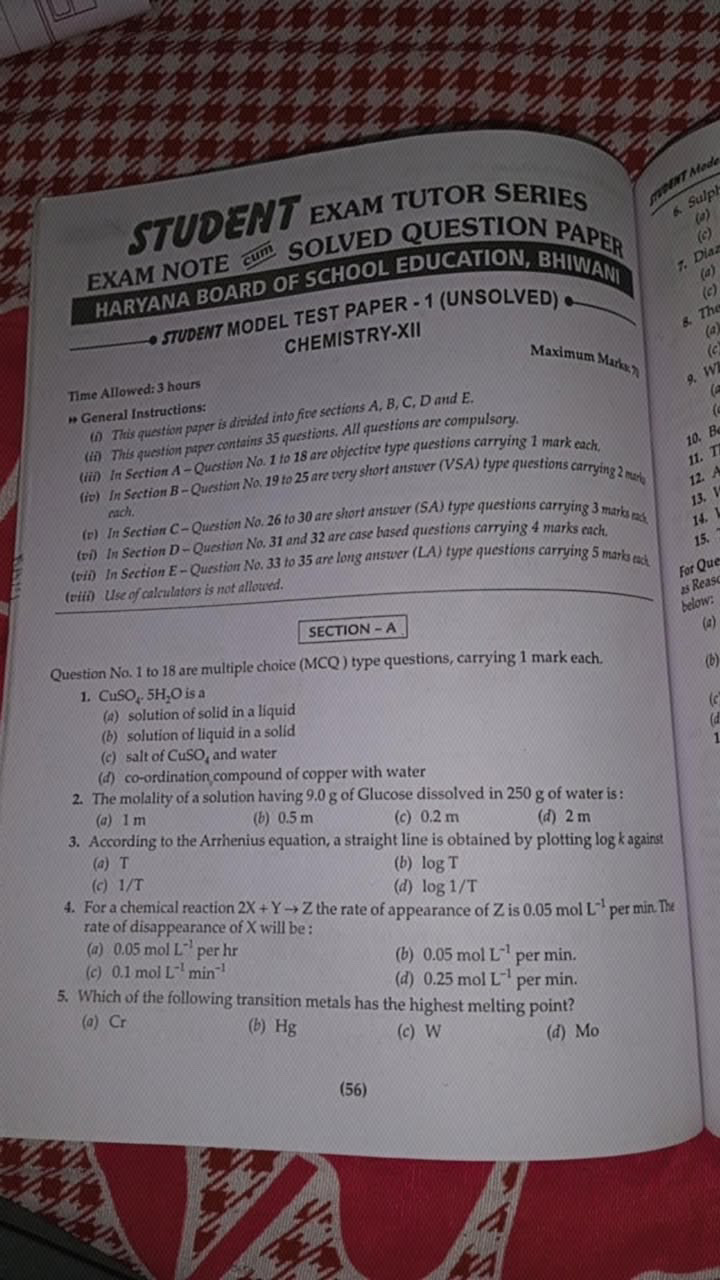Solve the following chemistry questions: 1. CuSO4.5H2O is a: (a) solution of solid in a liquid (b) solution of liquid in a solid (c) salt of CuSO4 and water (d) co-ordination comp... Solve the following chemistry questions: 1. CuSO4.5H2O is a: (a) solution of solid in a liquid (b) solution of liquid in a solid (c) salt of CuSO4 and water (d) co-ordination compound of copper with water 2. The molality of a solution having 9.0 g of Glucose dissolved in 250 g of water is: (a) 1 m (b) 0.5 m (c) 0.2 m (d) 2 m 3. According to the Arrhenius equation, a straight line is obtained by plotting log k against: (a) T (b) log T (c) 1/T (d) log 1/T 4. For a chemical reaction 2X + Y -> Z the rate of appearance of Z is 0.05 mol L-1 per min. The rate of disappearance of X will be: (a) 0.05 mol L-1 per hr (b) 0.05 mol L-1 per min. (c) 0.1 mol L-1 min-1 (d) 0.25 mol L-1 per min. 5. Which of the following transition metals has the highest melting point? (a) Cr (b) Hg (c) W (d) Mo

Understand the Problem
The image contains multiple chemistry questions from a test paper. Here's a breakdown of each question:
- Question 1: Asks about the nature of CuSO4.5H2O.
- Question 2: Requires calculating the molality of a glucose solution.
- Question 3: Deals with the Arrhenius equation and graphical representation.
- Question 4: Focuses on chemical kinetics and the relationship between the rates of appearance and disappearance of reactants and products.
- Question 5: Asks to identify the transition metal with the highest melting point.
Answer
1. (c) 2. (c) 3. (c) 4. (c) 5. (c)
- (c) salt of CuSO4 and water
- (c) 0.2 m
- (c) 1/T
- (c) 0.1 mol L-1 min-1
- (c) W
Answer for screen readers
- (c) salt of CuSO4 and water
- (c) 0.2 m
- (c) 1/T
- (c) 0.1 mol L-1 min-1
- (c) W
More Information
Here's how the answers were determined:
- CuSO4·5H2O is a hydrated salt, which can be considered a salt of CuSO4 and water.
- Molality is calculated as moles of solute/kg of solvent. Molar mass of glucose (C6H12O6) = 180 g/mol. Moles of glucose = 9.0 g / 180 g/mol = 0.05 mol. Molality = 0.05 mol / 0.250 kg = 0.2 m.
- The Arrhenius equation is k = A * exp(-Ea/RT). Taking the natural logarithm of both sides gives ln(k) = ln(A) - Ea/RT. Converting to log base 10 gives log(k) = log(A) - Ea/(2.303RT). Plotting log k against 1/T yields a straight line.
- The rate of disappearance of X is twice the rate of appearance of Z because of the stoichiometry of the reaction 2X + Y -> Z. Therefore, the rate of disappearance of X = 2 * 0.05 mol L-1 min-1 = 0.1 mol L-1 min-1.
- Tungsten (W) has the highest melting point among the given transition metals.
Tips
Make sure to understand the definitions of molality and the Arrhenius equation. Also, pay attention to stoichiometry when calculating reaction rates.
Sources
- CuSO4.5H2O is a - Tardigrade - tardigrade.in
- CuSO4⋅5H2O is a a. solution of solid in a liquid b. solution - Filo - askfilo.com
- CuSO(4).5H(2)O, a hydrated salt, is a coordination compound of Cu ... - doubtnut.com
AI-generated content may contain errors. Please verify critical information